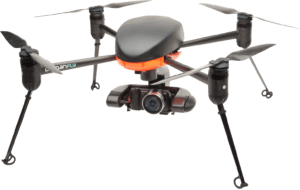
by Jim Magill
Emergency medical personnel in Texas will soon be able to deliver life-saving medicines and equipment via drones to victims of emergencies or disasters, thanks to a training program announced last month by Draganfly.
The training program got underway in August in Spring Branch, Texas, a city northeast of San Antonio. The training comprises the first phase of a multi-phase program launched by Draganfly and global supply chain company Coldchain Delivery Services, to incorporate drone intelligence gathering and deliveries into the state’s emergency management systems.
“Whether it’s a total disaster response or it’s an emergency response, the drone will often have the capability of being the first responder coming in,” Draganfly CEO Cameron Chell said in an interview.
He said many emergency situations occur in remote communities or involve roads that are made impassable, preventing the delivery of critical medical supplies or equipment to the people who need them most. “Imagine a hurricane, a tornado, a flood or the freeze like we had last winter,” Chell said.
The program, which will eventually be expanded to include firefighters and search and rescue teams in addition to emergency medical personnel, will instruct first responders in the use of drones to transport critical equipment and medical supplies and to transmit critical data to emergency and disaster relief operations centers.
Intelligence-gathering drones dispatched to disaster sites will be able to provide an initial assessment of the situation at the scene and transmit crucial data back to the first responders as they travel to the site in fire trucks and ambulances, Chell said.
At the disaster scene, specially equipped UAVs can perform air-quality monitoring – detecting toxic gasses and other pollutants – as well as optical monitoring of the site, to assess damage and locate survivors. They also can be equipped to measure survivors’ vital signs and report this data back to the response teams. “Our drones can read heart rates, respiratory rates, blood pressure, so they can take a health assessment of survivors on the ground,” Chell said.
This intelligence can be used to load transport drones with whatever supplies — bandages, water and even pain killers – that are most urgently required at the scene.
EMS Drone Pilot Training: First training class launched
Chell said about a dozen people are enrolled in the first phase of the training program, comprising EMS personnel and DraganFly and Coldchain employees. All are FAA Part 107-certified drone pilots.
The initial instruction will consist of flight training in which the trainees will learn about the payload capacities and flight characteristics of the several different drones used in emergency flight situations.
“The second part is understanding and assessing what mission will be flown, whether it’s environmental monitoring, situational awareness or actual delivery,” Chell said.
In the case of drones used for medical supply deliveries, trainees will learn which drone to use based on each vehicle’s payload capacities and how quickly the drone can be dispatched to the emergency scene. The trainees will also learn how to pack the drone’s payload compartment with emergency supplies and equipment as well as how to dispatch it the scene.
In addition to learning how to prepare and dispatch the drones, the trainees, many of whom themselves will be the first responders on the scene of an emergency, will also learn how to deal with drone deliveries; how to receive and unpack the drone’s sensitive cargo and how to send the vehicle back to its home base for further deployment.
Chell said the program’s organizers envision that once the program is adopted on a large scale, Texas EMS personnel will use the drones to deliver everything from water, vaccines and other medications, to portable pieces of medical equipment, such as defibrillators, to emergency sites. With the use of refrigerated units as payloads, the drones can even carry blood and other medical supplies that require storage and transport at cold temperatures.
The training program comprises Phase One of a five-phase roll-out of the partnership between Draganfly and Coldchain. In May, Coldchain announced it had entered into a $750,000 partnership agreement with the drone manufacturer “to develop, deploy and operate solutions for the delivery of medical supplies, medicine and vaccines.”
Phase One, which is expected to last 10 months, will include working with the FAA and other regulatory bodies to obtain the needed licenses and approvals for initial non-commercial beta-test delivery routes. Coldchain will spend $125,000 to implement Phase One. Under Phase Two, Coldchain is expected to buy $625,000 worth of equipment and services from Draganfly.
“We’ll be working through the different phases with folks at the FAA,” Chell said. The program’s organizers will provide the regulators with data to review and assess in the hopes of working out a regulatory path toward making the drone first responder program “a much more broad and permanent service,” he said.
Miriam McNabb is the Editor-in-Chief of DRONELIFE and CEO of JobForDrones, a professional drone services marketplace, and a fascinated observer of the emerging drone industry and the regulatory environment for drones. Miriam has penned over 3,000 articles focused on the commercial drone space and is an international speaker and recognized figure in the industry. Miriam has a degree from the University of Chicago and over 20 years of experience in high tech sales and marketing for new technologies.
For drone industry consulting or writing, Email Miriam.
TWITTER:@spaldingbarker
Subscribe to DroneLife here.